
Surviving
Fire Entrapments
Test Results
Also read about engine entrapment incidents:
|
 |
Surviving
Fire Entrapments
Comparing Conditions Inside
Vehicles and Fire Shelters |
Los Angeles County Burns
At Valencia in Los Angeles County, CA, two vehicles were available for
the burnover tests: the first was a "Crown" structural fire
engine, the other was a pickup patrol truck that had previously been equipped
with a slip-on pumper unit. The Crown engine had hose in the hose bed,
and a ladder hung on the side as it would normally be configured.
Two burns took place on June 5 and 6, 1996, in dry, cured grasses 12
to 24 inches (30 to 61 cm) tall, with a 2- to 3- foot (0.6- to 0.9-m)
chamise brush overstory (NFFL Model 5). Air temperatures were approximately
32 °C, with wind speeds of 5 to 10 miles per hour (8 to 16 km per
hour) during the burns. Flame lengths averaged 12 to 20 feet (4 to 6 m),
with short periods (less than 30 seconds) where lengths were 20 to 30
feet (6 to 9 m).
The June 5th burn took place on slopes averaging 70%. The engines, fire
shelters, and PPE were on a road near the top of the slope (Figure 3).
Flames came in direct contact with the engines and shelters, since they
were positioned at the road's edge to receive the maximum effect of the
flaming front (Figure 15).

Figure 15-This image (taken from video) shows the intensity of the June
5 burn in Los Angeles County.
This burn occurred in heavier fuels and on a day with higher air temperatures
than the Florida burn. It produced a significant amount of meaningful
data:
- Air temperatures measured in the free air outside the engines peaked
at 1000 °C between 48 and 60 inches (122 and 152 cm) AGL.
- Radiometers measuring heat flux at the 3-, 6-, and 9-foot (0.9-, 2-,
and 3-m) levels recorded a maximum heat flux of 70kW/m2 for periods
less than 10 seconds, and long term fluxes of 15 kW/m2; the levels decreased
as the height above the ground increased from 3 to 9 feet (0.9 to 3
m).
- Temperatures measured inside the engine cabs ranged from 60 to 85
°C.
- Outside skin temperatures on the standard fire shelter were 430 °C
at the Crown engine and 180 °C at the patrol engine. Inside the
shelter adjacent to the Crown engine, temperatures ranged from 150°C
at 1 inch (3 cm) AGL to 220 °C at 12 inches (30 cm) AGL.
- Items of personal protective clothing laid out beside the engines
and shelters showed serious degradation from the intense heat during
the burnover. A difference of less than a foot (30 cm) from the fire
made a significant difference in damage to the clothing (Figure 16).
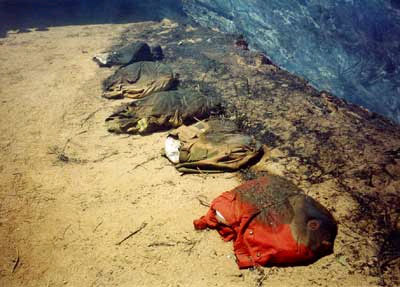
Figure 16-These items of personal protective clothing show the effects
of the June 5 burn in Los Angeles County. Note the difference made
by being just a few feet from the edge of the roadway.
- On the stainless steel shelter, outside skin temperatures reached
520 °C, with the inside skin temperatures reaching 220 °C. Inside
temperatures were 160 °C at 1 inch (3 cm) AGL and 250 °C at
12 inches (30 cm) AGL.
- The personal protective equipment laid on the ground showed varying
degrees of damage from the combination of direct flame contact and radiant
heat.
- Neither fire shelter showed any visible sign of heat damage.
- The Crown engine showed these signs of damage:
- Windows cracked in the cab.
- The 4-inch (10-cm) cotton-jacketed, rubber-lined hose in the exposed
bed on the back of the engine melted in some places and began dripping.
- The mud flap on the rear tire caught fire (Figure 17).
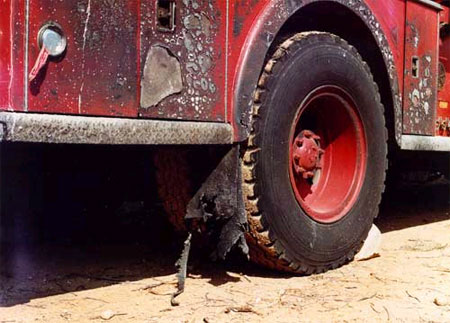
Figure 17-Mudflaps are just one of the flammable items on the engine's
exterior.
- The exterior ladder hanging outside the engine was badly scorched.
- The brake line at the rear of the engine burned through, rendering
the engine immovable because the air brakes locked.
- Windows were cracked on the patrol engine and the paint was scorched.
The cab filled with heavy smoke, even though nothing burned inside the
cab. Video footage filmed inside the cab showed heavy smoke within 1
minute after fire reached the engine.
- The heat lasted longer inside the engine cabs than it did inside the
fire shelters.
The table below shows the levels of six gases in a vehicle and in a fire
shelter.
| Gases (parts per million) |
Engine |
Shelter |
| SO2 |
18.7 |
4.4 |
| HCN |
0.0 |
0.0 |
| Benzene |
1.5 |
0.8 |
| HCl |
7.8 |
1.0 |
| Toluene |
13.6 |
6.3 |
| CO |
29.3 |
5.5 |
The second burn in Los Angeles County was on June 6th, the next day.
Weather conditions were nearly identical, but the slope, aspect, and fuel
loading were different. The engines were positioned at the head of a small
draw with 35 to 45% slopes (Figure 18). Some chamise brush was cut and
piled next to the engines and shelters to increase the fire's intensity
and duration. Because of the topographic effect of some adjacent spur
ridges, the flames were diverted from the engines and shelters.
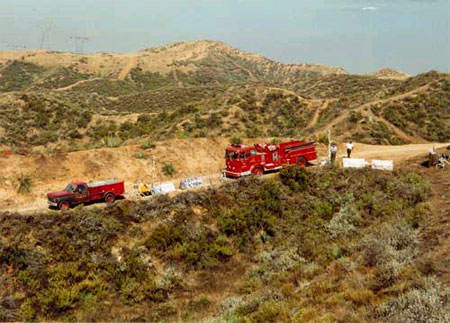
Figure 18-The engine, patrol engine, and fire shelters positioned for
the second burn in Los Angeles County, June 6th.
Although the engines and shelters had less direct flame contact than
expected, important data were obtained from the effects of the radiant
heat load:
- Air temperatures outside the Crown engine reached a maximum of 700
°C at 60 inches (152 cm) AGL, and a maximum of 75 °C inside
the cab (40 °C on the floor inside the cab).
- The patrol engine (Figure 19) had outside air temperatures of 440
°C, with inside air temperatures of 280 °C at the roof. The
inside door panel on the driver's side caught fire, leading to the high
temperatures inside the cab of the patrol engine (Figures 20 and 21).
Floor temperatures were 45 °C.

Figure 19-The patrol engine caught fire during the June 6 burn in
Los Angeles County.
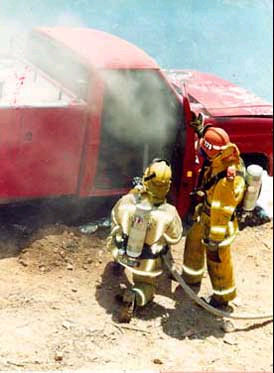
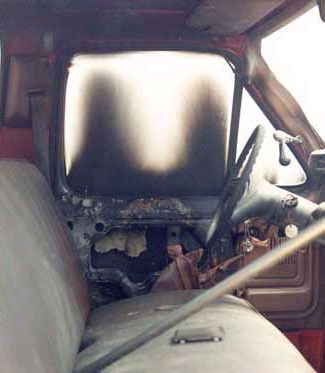
Figures 20 and 21-Firefighters put out the fire in the cab of the
patrol pickup. Material on the inside door panel burned, emitting
smoke that would have forced entrapped firefighters to leave the truck.
- The maximum outside skin temperature of the standard fire shelter
adjacent to the Crown engine was 300 °C, with inside skin temperatures
of 180 °C. Air temperatures stayed below 80 °C at both the 1-
and 12-inch (3- and 30-cm) levels inside the fire shelter.
- The stainless steel shelter adjacent to the patrol engine had a maximum
outside surface temperature of 360 °C, while the inside surface
reached a maximum of 120 °C. The air temperature inside the shelter
reached a maximum of 180 °C.
- Video footage showed that the cab of the patrol engine filled with
dark smoke in less than 60 seconds. The driver's side door panel caught
fire from radiant heat on the outside of the door;
- PPE and additional fire shelters- both the standard Forest Service
version and the stainless steel prototype-were placed at the head of
the small draw away from the engines and other shelters. We intended
to subject these items to direct flame contact and the maximum radiant
heat load. The effect of the terrain prevented direct flame contact.
Temperatures inside the stainless steel shelter reached a maximum of
135 °C, while temperatures inside the standard shelter reached just
70 °C. The PPE laid out in the open, including FR cotton coveralls
from the Northwest Territories of Canada and standard FS Nomex, reached
maximum temperatures of 120 °C. The clothing showed no visible signs
of damage.
LOS
ANGELES-JUNE 5TH
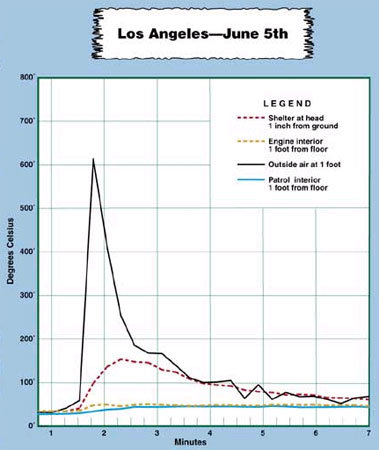
LOS
ANGELES-JUNE 6TH
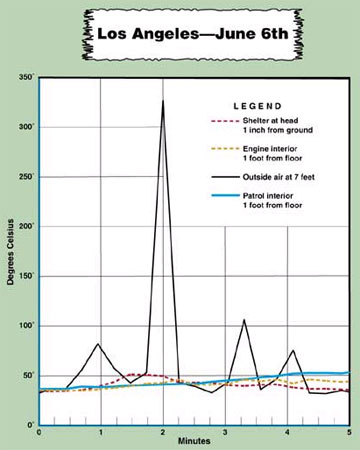
<<< continue
reading—Surviving Fire Entrapments, Montana Burn >>>
|
